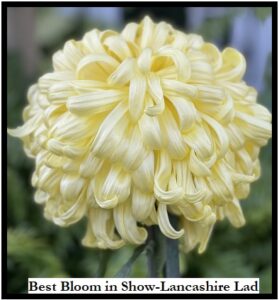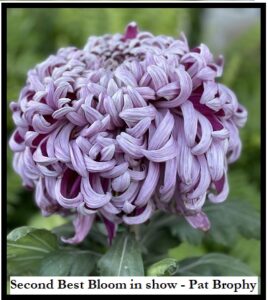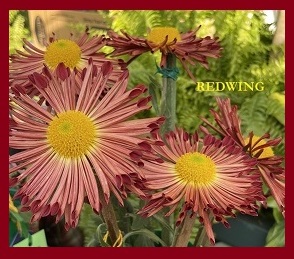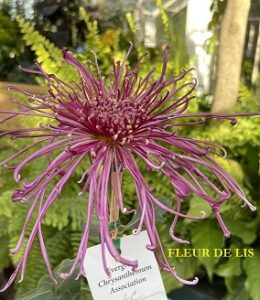January 2021 Cultural Notes – drs 2016
To Do LIST -January
1. get your stools growing and producing shoots for cuttings. You should have several already producing good shoots for January cuttings
2. Clean up your cutting beds, check temperature sensors overhead lights etc. See Dec. 2020 news letter for details.
3. Lay out your growing plans for the year- What verities and how many you plan to grow. I like to break it down to 3 or four sections i.e. -Large and Mediums (#1s & #2s) -Incurves (#3s & #13s ) -Late Decoratives & Fantasies -Early English and Garden Varieties and -Any special categories you may be growing
4.Plan your pinch dates and starting dates
5. Start the cuttings per your plan; refer to previous notices or your ECA Novice Handbook
6. Collect material you will need when transferring cuttings to next stage; i.e. 21/2 inch cross bottom cubes– M&R mix, or other soilless growing mix, plant labels, B-9 stem growth retardant etc.
Cultural notes
1. Taking cuttings: The club now follows either of two basic starting media/methods for starting the cuttings: -the first method employs the old standard cutting bed where cuttings are placed in rows in the starting media. separated as chosen by the grower. The basic cutting bed material being peat moss and sand or our standard growing M&R mix , or sometimes starting directly in 2 1/2 inch cross bottom cubes. Don stark starting media was 60% ProEarth#2 and 40 % Green Mountain sharp white sand. The sharp white sand helps produce many more roots as the sharp edges penetrate the cambion layer and new roots develop where the layer was broken. -The alternative cutting method employed by several uses “Earth Pots”. A few years ago Chris Brookes picked up on this method used by Ray Gray of Kings Mums in his large scale commercial business. The Earth pots come in trays of 72 starting modules containing the required soilless ingredients. The cuttings are inserted directly into each module. A cutting bed not required per se; but you still, but you still need to provide controlled under the pot heat, overhead protection (Covers), overhead lighting and frequent overhead spraying. The Earth pots come in trays of 72 pots. Mark Ross is the focal point for ordering the Earth pots and you need to order them a month in advance. Both methods have shown to produce excellent rooted cuttings, The Earth Pots are liked by several grows because they allow a denser starting flat (72 starts per flat. Downsides include additional costs and the need for frequent spraying. The cutting bed seems to have an advantage with the white Sand enabling more roots per cutting and the ability to get a good look at the roots when they are taken from the bed. Of course the starting media or the under flat temperature must be controlled (65-69 DEG) by heating heating elements such as heat pads, heat coils, heated room etc.
2. Starting dates: There is always varying opinion for different starting dates. let’s try to put some logic into the Question. First we must recognize that different varieties require different starting dates to provide the best chance of getting a full flowered bloom read for our show date which is scheduled for Oct 29th -31st this year. It has always been my position that for most of the year we must concentrate primarily on root development. In line with that position I generally recommend that we get our final potting, (8″ or 9″ pots) completed by the first to the fifteenth of June. This allows sufficient time to develop strong fully root bound roots by the time we expect the buds to appear. A basic tenant for pot grown plants is that the plants seldom bud out until they become root bound. if you are still potting-on into July you don’t have sufficient time to develop roots before you need buds to appear. The result is often late and anemic blooms. pushing them along with additional fertilizer can’t really save them. This concept is mostly independent of the planned stopping dates. All that having been said there is still a lot of latitude in selecting your starting dates; including tardiness in getting your stools growing early enough to take healthy cuttings . You each will have to decide when to take your cuttings. To give you some Ideas I’ve listed my generalized starting dates. maybe they will be helpful, but keep in mind there are different growing facilities and climates so these might not all fit your needs. Hopefully it’s a start. – Late Dec & early to mid January, Mount Rainer, Elsie Prosser James Bryant, Keith Luxford, All Fairweathers, Most Fantasies (Spiders, quills and spoons). King George, plus anything you plan to grow for specimen plants (10 or more blooms). -Late Jan. Connie Mathew, Seychelles, Dukes, Jessie Habgood – February, Lundys, Harry Gees (all), Jane Sharpe, Ralph Lamberts, Athabasca, -Late Feb. to early march, Lots of #4s & #5s plus garden varieties. To some extent, we as a club may have been starting many varieties earlier than necessary. Many of us have started fairly early because of usual April blahs where our plants tend to stall out and we barely get our plants into the final pots by early June. Many have overshot the desired potting-on dates resorted to using 8″ pots for the final potting in order to get the root system more quickly semi root bound. That works to some extent, but keep in mind that we are trying to attain exceptional flowers and the smaller pot with less roots significantly limits the potential of the final blooms Most of the above relates to the Exhibition class mums; Sections 1 through 15. -Early English classes , sections 23 through 25 and to some extent classes 13 through 15 are a different story entirely as they have been cultivated and developed mainly for growing in the open garden, not in pots. They tend to bud more quickly and flower earlier than the other varieties. Further, their budding dates are not usually affected by the need for roots to become semi root bound. Most garden varieties fall into this same category. One final note regarding cuttings. We need healthy strong growing shoots for the cuttings in all cases. It is better to delay starts to get a healthier cuttings than to take earlier week cuttings. Another observation is that the shoots tend to be growing faster in February and on.
3. Use of B-Nine to control plant Height. We have been recommending B-Nine to control the height of our plants. In general it is recommended the first application be made when potting on from the cutting bed. This works quite wee in most cases, but there several varieties that are generally quite short, and B-Nine is not beneficial as they could be so limited in height one could not produce a significantly long stem. To name a few here’s a list of those cultivars where B-Nine should not be used. -All Fairweathers, -Alexis -West Bromwich King George -And all shorties.




